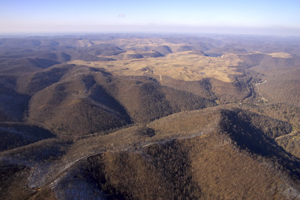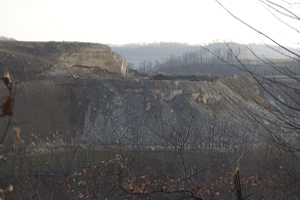
A Guest Blog by Brandon Nida, Organizer—Blair Mountain Heritage Alliance
Many people have not heard of the Battle of Blair Mountain, let alone a place called Adkins Fork in Logan County, West Virginia. But in 1921, the Adkins Fork area was the scene of an intense battle between miners attempting to organize and a private army trying to stop them. It is part of the larger Blair Mountain battlefield that stretches 14-miles along Spruce Fork Ridge, the site of the largest labor battle in US history. Ten thousand miners fought for five days against the private army entrenched on the ridgeline, with both sides having high-powered rifles and machine guns. Three regiments of federal troops sent by President Harding were finally able to halt the conflict.
Currently Adkins Fork and the larger Blair Mountain battlefield is threatened by an extremely destructive form of coal mining called mountaintop removal (MTR). This is a process where mountains are blasted and a huge amount of leftover material is pushed into valleys, filling them up and creating a flat moonscape where rolling hills and hardwood forest once were. MTR is a process that in recent years has increasingly been tied to health problems such as rare forms of cancer, respiratory illnesses, and birth defects.
At the foot of Blair Mountain is the town of Blair, where I live and work. In the late 1990s, Blair was a community of about 700 people, and currently there are only about 70 residents left. Aggressive buyouts preceded plans to MTR mine around the town and led to the systematic depopulation of the area. The people who remained had to live with constant blasting behind the town, carcinogenic dust rolling off the site, and the contamination of drinking water with heavy metals. But people from Blair were some of the first coalfield residents to speak out against MTR, something that is hard to do in central Appalachia where the coal industry dominates the social and political landscape.
Currently we are fending off six different permits that would impact the battlefield and the communities around it. Our biggest struggle is with the Adkins Fork permit, which is situated in the heart of the battlefield and right above the headwaters of the town of Blair. The Adkins Fork permit is currently up for renewal, and we have mounted a major campaign to block this permit. This campaign will be a tough one and will continue over the next few months.
The Adkins Fork permit, which is being sought by Arch Coal, is symbolic of the increasing risk that investors and banks are taking by investing in companies (like Arch Coal) that have MTR operations. It is a permit that has multiple deficiencies, and is being contested by a wide range of concerned citizens, including: community members, retired coal miners, archaeologists, labor groups, environmentalists, and others across central Appalachia and the rest of the nation.
If Arch Coal is able to proceed with the Adkins Fork permit, they would destroy one of the only areas we know for certain was occupied by the miners during the Battle. Along with this permit, there are currently 17,000 acres permitted or under review for the Spruce Fork watershed. It is comprised of geological strata high in selenium. Selenium is a bio-accumulative compound that is highly detrimental to the nervous system of animals and humans, and is extremely expensive to contain or remove from the ecosystems once it is released. This small compound is one of the reasons Patriot Coal, a major operator of MTR mining in Central Appalachia, was forced to publicly halt all MTR operations just last month. Streams in the Spruce Fork watershed have already been shown to have higher amounts of selenium than regulation allows.

In addition to Arch Coal seeking a permit that has a wide coalition of people opposing it and which has high levels of selenium, the risk investors take when putting their money into companies like Arch continues to increase. The West Virginia State Historic Preservation Office refuses to sign off on this permit due to the destruction of major archaeological resources. Valley fills, of which the Adkins Fork permit has three, have been coming under increasing scrutiny by federal regulators. With the stripping of thousands of acres of vegetation and topsoil, the risk of flooding becomes more prevalent. As more peer-reviewed science shows the link between MTR and severe health problems, companies such as Arch are finding it harder to externalize these risks onto communities such as the town of Blair.
For these reasons and more, those who continue to invest in companies like Arch that conduct strip mining operations such as the Adkins Fork permit take on increasing risk. Right now, Arch Coal’s stock is down to around seven dollars per share from a high of around 73 per share in 2008. Arch Coal’s credit rating is Ba3 sub-prime, just one level above where Patriot Coal (NYSE: PCX) was before going bankrupt.
The Adkins Fork permit is just one permit by Arch Coal that would impact the town of Blair and the Blair Mountain battlefield. Companies such as Arch are attempting to destroy not just the environment, but whole communities, heritage, and people’s health. Citizen groups and environmental organizations have become more proficient in being able to challenge and block these permits. In fact, one of the only operations to have been halted in mid-operation was in Blair – the Daltex surface mine operated by Arch Coal. In addition, the Spruce No. 1 surface mine, which is the largest MTR mine ever permitted in central Appalachia and which sits on another ridge above Blair, has been the subject of intense litigation for over a decade.
For those of you who would like to take part in stopping companies like Arch Coal and Alpha Natural Resources (ANR) from destroying the Blair Mountain battlefield and other mountains in central Appalachia, there are definite ways you can help and join in our efforts. Even if you live far away, we need you to take a stand and join in our Adkins Fork campaign and the larger efforts to preserve Blair Mountain and stop MTR.
The first step is working in solidarity with a group of community members, organizers, retired coal miners, archaeologists, historians, environmentalists, and others who will be taking part in a public conference with the West Virginia Department of Environmental Protection this Thursday. While we attempt to show the WV DEP why this permit renewal should be denied, we need as many people as possible to circulate and sign our petition directed at the banks and investors who enable companies like Arch Coal to engage in these destructive operations.
This is not just about one permit, or one mountain, or one community, but is symbolic of the larger problem of destructive practices such as MTR, and the increasingly reckless investment and financing of these types of operations.
Take a stand today, and join our team. Tell banks and investors to stop financing the destruction of our homes and health. Stand with us and stay connected as we move through this national campaign. Only together can we stop destructive extractive processes such as MTR.
 Brandon Nida is a native West Virginian who currently lives in Blair, WV. He is an organizer with the Blair Mountain Heritage Alliance, a board member of the Ohio Valley Environmental Coalition, and a member of the United Auto Workers. He is currently finishing the doctorate program in Anthropology/Archaeology at UC Berkeley.
Brandon Nida is a native West Virginian who currently lives in Blair, WV. He is an organizer with the Blair Mountain Heritage Alliance, a board member of the Ohio Valley Environmental Coalition, and a member of the United Auto Workers. He is currently finishing the doctorate program in Anthropology/Archaeology at UC Berkeley.